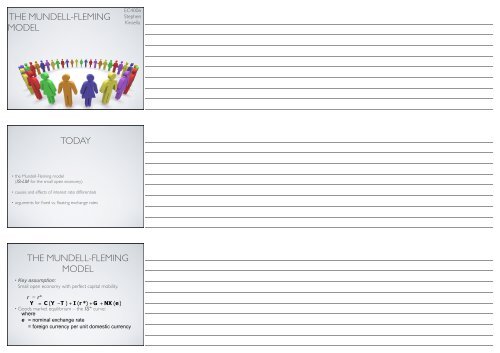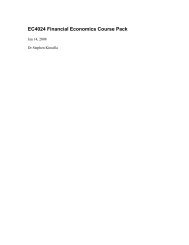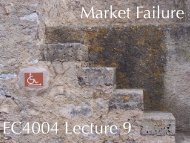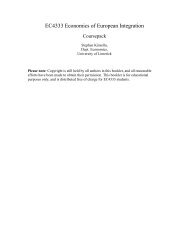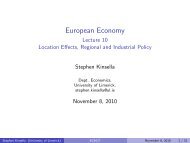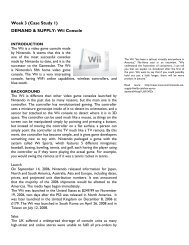Here's a handout of the slides - Stephen Kinsella
Here's a handout of the slides - Stephen Kinsella
Here's a handout of the slides - Stephen Kinsella
You also want an ePaper? Increase the reach of your titles
YUMPU automatically turns print PDFs into web optimized ePapers that Google loves.
THE IS* CURVE: GOODS MARKET EQ’MThe IS* curve is drawn for agiven value <strong>of</strong> r*.eIntuition for <strong>the</strong> slope:Remember, <strong>the</strong> IS curve incorporates<strong>the</strong> multiplier effect.IS*YTHE LM* CURVE: MONEY MARKET EQ’MThe LM* curve! is drawn for a givenvalue <strong>of</strong> r*.eLM*! is vertical because:given r*, <strong>the</strong>re isonly one value <strong>of</strong> Ythat equates moneydemand with supply,regardless <strong>of</strong> e.YEQUILIBRIUM IN THE MUNDELL-FLEMING MODELeLM*equilibriumexchangerateequilibriumlevel <strong>of</strong>incomeIS*Y
FLOATING & FIXEDEXCHANGE RATES• In a system <strong>of</strong> floating exchange rates,e is allowed to fluctuate in response to changing economicconditions.• In contrast, under fixed exchange rates,<strong>the</strong> central bank trades domestic for foreign currency at apredetermined price.• Next, policy analysis –• first, in a floating exchange rate system• <strong>the</strong>n, in a fixed exchange rate systemLESSONS ABOUT FISCALPOLICY• In a small open economy with perfect capital mobility, fiscal policycannot affect real GDP.• “Crowding out”• closed economy:Fiscal policy crowds out investment by causing <strong>the</strong> interest rate torise.• small open economy:Fiscal policy crowds out net exports by causing <strong>the</strong> exchange rateto appreciate.MONETARY POLICY UNDER FLOATINGEXCHANGE RATESAn increase in Mshifts LM* rightbecause Y must riseto restore eq’m in<strong>the</strong> money market.e 1e 2eResults:!e < 0, !Y > 0Y 1 Y 2Y
! Monetary policy affects output by affecting<strong>the</strong> components <strong>of</strong> aggregate demand:closed economy: "M # $r # "I # "Ysmall open economy: "M # $e # "NX # "Y! Expansionary mon. policy does not raise world agg.demand, it merely shifts demand from foreign todomestic products.! So, <strong>the</strong> increases in domestic income and employmentare at <strong>the</strong> expense <strong>of</strong> losses abroad.TRADE POLICY UNDER FLOATINGEXCHANGE RATESeAt any given value <strong>of</strong> e,a tariff or quota reducesimports, increases NX,and shifts IS* to <strong>the</strong> right.NX does not change! Why?Results:!e > 0, !Y = 0e 2e 1Y 1YLESSONS ABOUT TRADEPOLICY• Import restrictions cannot reduce a trade deficit.• Even though NX is unchanged, <strong>the</strong>re is less trade:• <strong>the</strong> trade restriction reduces imports.• <strong>the</strong> exchange rate appreciation reduces exports.• Less trade means fewer “gains from trade.”
FIXED EXCHANGE RATES• Under fixed exchange rates, <strong>the</strong> central bank stands readyto buy or sell <strong>the</strong> domestic currency for foreign currencyat a predetermined rate.• In <strong>the</strong> Mundell-Fleming model, <strong>the</strong> central bank shifts <strong>the</strong>LM* curve as required to keep e at its preannouncedrate.• This system fixes <strong>the</strong> nominal exchange rate.In <strong>the</strong> long run, when prices are flexible,<strong>the</strong> real exchange rate can move even if <strong>the</strong> nominal rateis fixed.Under floating rates,a fiscal expansionwould raise e.To keep e from rising,<strong>the</strong> central bank mustsell domestic currency,which increases Mand shifts LM* right.Results:FISCAL POLICY Under UNDER floating FIXED rates, EXCHANGEfiscal RATES policy is ineffectiveat changing output.!e = 0, !Y > 0Under fixed rates,fiscal policy e is veryeffective at changingoutput.e 1Y 1Y 2YMONETARY POLICY UNDER FIXEDEXCHANGE RATESUnder floating rates,monetary policy isvery effective at changingAn increase in M wouldoutput.shift LM* right and reduce e.To Under prevent fixed <strong>the</strong> rates, fall in e,<strong>the</strong> monetary central bank policy must cannot buydomesticbe usedcurrency,to affectwhichoutput.reduces M and shifts LM*back left.Results:!e = 0, !Y = 0e 1eY 1Y
SUMMARY OF POLICY EFFECTS IN THE MUNDELL-FLEMING MODELtype <strong>of</strong> exchange rate regime:floatingimpact on:fixedPolicy Y e NX Y e NXfiscal expansion 0 " $ " 0 0mon. expansion " $ " 0 0 0import restriction 0 " 0 " 0 "FLOATING VS. FIXED EXCHANGE RATESArgument for floating rates:! allows monetary policy to be used to pursue o<strong>the</strong>r goals (stablegrowth, low inflation).Arguments for fixed rates:! avoids uncertainty and volatility, making international transactionseasier.! disciplines monetary policy to prevent excessive money growth &hyperinflation.THE IMPOSSIBLE TRINITYA nation cannot have freecapital flows, independentmonetary policy, and a fixedexchange rate simultaneously.A nation must chooseone side <strong>of</strong> thistriangle andgive up <strong>the</strong>oppositecorner.IndependentmonetarypolicyOption 1(U.S.)Free capitalflowsOption 3(China)Option 2(Hong Kong)Fixedexchangerate
INTEREST-RATEDIFFERENTIALSTwo reasons why r may differ from r*! country risk: The risk that <strong>the</strong> country’s borrowers willdefault on <strong>the</strong>ir loan repayments because <strong>of</strong> political oreconomic turmoil.! Lenders require a higher interest rate to compensate<strong>the</strong>m for this risk.! expected exchange rate changes: If a country’sexchange rate is expected to fall, <strong>the</strong>n its borrowers mustpay a higher interest rate to compensate lenders for <strong>the</strong>expected currency depreciation.EXPECTED CHANGE INEXCHANGE RATES• When a foreigner buys a domestic bond, <strong>the</strong>y really earn more thanjust r, <strong>the</strong> interest rate.• They are holding a euro asset. Foreigners gain if <strong>the</strong> euro itself gainsvalue relative to <strong>the</strong> foreign currency.• The expected appreciation <strong>of</strong> <strong>the</strong> euro:INTEREST PARITY• The total expected return for a foreigner is• “Interest parity” says that <strong>the</strong> return on <strong>the</strong> home country’s bondsequal <strong>the</strong> foreign interest rate:
INTEREST RATES ANDEXCHANGE RATES• We can rewrite <strong>the</strong> interest parity equation to get a relationship thatsays <strong>the</strong> exchange rate is determined by home and foreign interestrates, and <strong>the</strong> expected future exchange rate:• Home currency is stronger if:• Home interest rate, r, rises• Foreign interest rate, r*, falls• Expected exchange rate increasesSUMMARY• When we allow for expected changes in <strong>the</strong> value <strong>of</strong> <strong>the</strong> currencyand use interest parity, <strong>the</strong> model is like <strong>the</strong> closed economy IS-LM.• The IS curve is flatter because a drop in <strong>the</strong> interest rate also causese to fall, which stimulates net exports.• The expected exchange rate, e e , and <strong>the</strong> foreign interest rate, r*, canaffect <strong>the</strong> IS curve.


